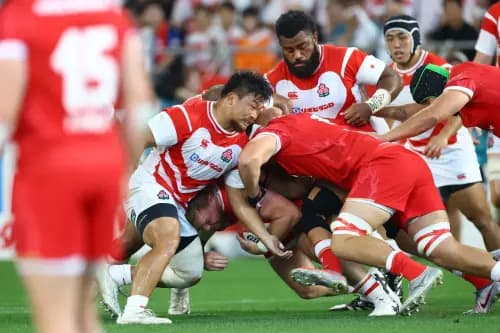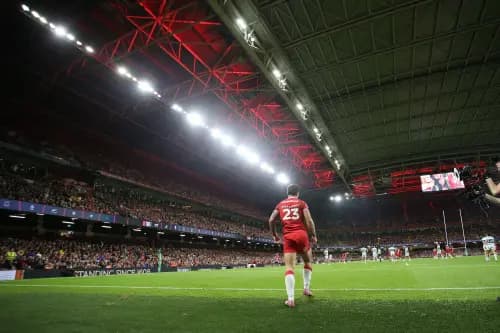Between 1950 and 2009 England schoolboy international football matches were played at the old Wembley Stadium.
The televised fixtures attracted huge attendances at the venue of up to 95,000, mostly made up of young fans.
The noise when England attacked could be described as more of a screech than a roar as thousands of unbroken voices cheered on their team.
I was reminded of that sound during the Wales v Argentina match at the Principality Stadium on Sunday.
While not quite as shrill as the Wembley cheers of yesteryear, there was a similar tone in the air whenever Louis Rees-Zammit’s name was mentioned by the stadium announcer.
As Wales’ starting line-up was shared before the game, unsurprisingly the biggest cheer was reserved for inspirational skipper and British Lion Jac Morgan.
But the decibel level almost went through the closed roof when the final name on the home team’s replacement bench was called out - “number 23, Louis Rees-Zammit”.
READ MORE: Louis Rees-Zammit is Winning Again . . . Now Comes Trying to Win For Wales
There was a similar reaction in the 44th minute of the match when the winger was enthusiastically welcomed onto the pitch and back to the Wales fold following his bid to become an NFL star in the United States.
The Wembley echo from the past may have been due to a large percentage of youngsters in the 50,000 crowd, thanks to the relatively attractive pricing structure for juniors.
But the high-pitched cheers certainly seemed to coincide with Rees-Zammit’s name being mentioned, suggesting the 24-year-old - who has a huge social media presence - is still a big favourite with young fans.
Back in August, when the WRU first mooted its consultation into the future of elite rugby in Wales, it’s chair, Richard Collier-Keywood, suggested some fans followed players now, rather than teams.
READ MORE: Louis Rees-Zammit Is Upbeat on Fitness as Wales Prepare for Argentina Test
Options put forward for public discussion included the potential culling of two out of the current four Welsh regions.
Collier-Keywood’s comment appeared to imply fans of potentially axed regions would simply follow their favourite players to their new employers.
"It's more complicated in the social media era, that supporters follow individual players as well. So it's a complicated equation,” said Collier-Keywood.
His comments were met with howls of derision from some quarters.
When Morgan left the Scarlets for the Ospreys, did a hefty chunk of the Parc Y Scarlets faithful rip up their season ticket renewals and set their sat navs for the Swansea.Com Stadium?
READ MORE: The Special One . . . Louis Rees-Zammit Gets the Big Build-Up From New Wales Coach Steve Tandy
Of course they didn’t. Rugby fans follow clubs, regions and countries, was the counter argument to Collier-Keywood’s comment.
Well, that may be case for older fans like me.
But what about those youngsters who are part of the new social media era referenced by the WRU chair?
On the evidence of LRZ’s popularity inside the Principality Stadium on Sunday afternoon, does the WRU chair have a point after all?
Will future generations indeed follow the cult of celebrity rather than the old tribal ways of Welsh rugby?
READ MORE: Louis Rees-Zammit Back for Wales, Plus "Exiled" Rhys Carre, With Recall for Callum Sheedy
At the announcement of the consultation, WRU director of rugby and elite performance, Dave Reddin said: "We are asking people to let go of the past and the present and imagine a completely different future."
More recently, when the WRU announced their updated plans to cut one of the regions, Reddin said: “Frankly, I don’t care who beat the All Blacks 40 years ago."
There were still nods to the past on Sunday before the new Steve Tandy coaching era got underway on the pitch.
Under the leadership of musical director Dr Haydn James, massed choirs from around Wales produced rousing renditions of the old Welsh hymns like Gwahoddiad, Calon Lân and Cwm Rhondda, along with the more recent Dafydd Iwan favourite Yma o Hyd, accompanied by the Tredegar Town Band.
Few things scream Welsh rugby nostalgia like male voice choirs and brass bands on the pitch before an international match in Cardiff.
READ MORE: Louis Rees-Zammit Poised For Fast Return as Steve Tandy Era Begins
One of the enduring memories from attending my first international as a squeaky-voiced schoolboy was standing on the vast East Terrace and joining in as the crowd spontaneously burst into the aforementioned hymns.
Is it time for old dinosaurs like me to blink away that misty-eyed romanticism of the past for a steely-eyed pragmatism in search of greater success on the pitch?
It’s now 30 years since rugby union turned fully professional. The game and the world in general have changed immeasurably in those three decades.
Perhaps in Welsh rugby’s brave new world, fans will indeed follow players from one organisation to another, wherever those entities may be based and whatever name they may adopt.
However, that’s all well and good if the players themselves stay in Wales when their current employers are axed or merged.
What if they cross the Severn Bridge to England, or beyond? It’s certainly a likely step, given all the uncertainty surrounding the future.
A sizable chunk of the current squad earn their living outside of Wales as it stands. As such they won’t be available for the final match of this year’s Quilter Autumn Series as it falls outside World Rugby’s international window.
It’s already an ominous and immediate concern as that fixture on November 29th is against the mighty South Africans.
During Sunday’s 28-52 defeat to Argentina, the list of absentees for the impending visit of the world champions was further extended.
Morgan’s outstanding performance was cut short in the act of scoring a typically defiant try to give his team a glimmer of hope in a match that was already slipping away.
More worrying in the longer term, the talismanic Morgan reportedly said in September that he will leave Welsh domestic rugby if the Ospreys cease to exist.
Further stories emerged that he had already held talks with Saracens and could quit Wales next summer to replace Bordeaux-bound England international Tom Willis.
Wales’ only other Lion on last summer’s tour to Australia, Tomos Williams, who combined superbly with Morgan for the home side’s first try, already plays in England with Gloucester.
Meanwhile, Rees-Zammit has never played senior professional rugby in Wales, having made his name with Gloucester.
Following his American adventure he returned to the south west of England to link up with Bristol Bears.
While Rees-Zammit will continue to generate huge publicity for the Welsh national team, there will be no direct domestic benefit from his popularity in the foreseeable future.
So, that’s arguably Wales’ three best and highest profile players, already plying their trade away from their homeland, or planning to.
How many will follow if and when the WRU’s brave new world is eventually introduced?
If fans really do follow players as well as teams, how many will be left behind to cheer on the players who stay in Wales?
Whenever and wherever the proposed new structure for Welsh domestic rugby eventually kicks off, who will still be around to cheer on the remaining teams and proudly sing Yma o Hyd?
Yma o Yd. . . we're still here.
But will the players be?







